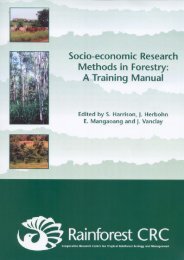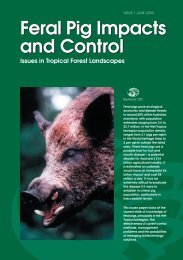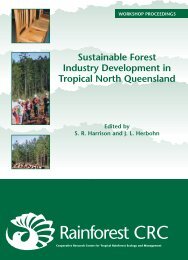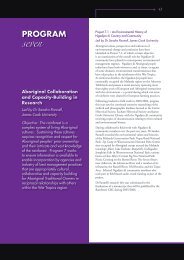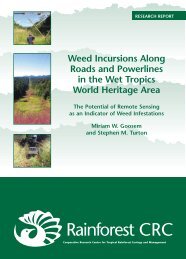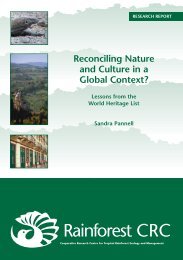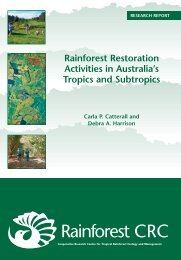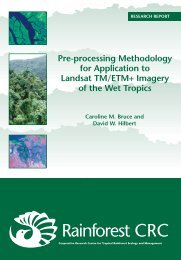Reconciling Nature and Culture in a Global Context? - Rainforest ...
Reconciling Nature and Culture in a Global Context? - Rainforest ...
Reconciling Nature and Culture in a Global Context? - Rainforest ...
You also want an ePaper? Increase the reach of your titles
YUMPU automatically turns print PDFs into web optimized ePapers that Google loves.
S<strong>and</strong>ra Pannellwith the “traditional l<strong>and</strong>-use pattern”, have been rejected by the Park authorities 67 (ICOMOS2004: 135). Certa<strong>in</strong>ly, heritage tourism <strong>in</strong> the region promotes the ‘caught <strong>in</strong> time’ qualitiesthe Park management plan strives to ma<strong>in</strong>ta<strong>in</strong>. Tourism is focused upon Agriturismo, or‘farmstays’, the commercialisation <strong>and</strong> promotion of ‘traditional’ agricultural products <strong>and</strong>h<strong>and</strong>icrafts, <strong>and</strong> upon showcas<strong>in</strong>g the tangible cultural heritage of the region. As KarenThompson observes, ‘heritage products’ based upon the idea of ‘tradition’ or the ‘relics offormer civilisations’ have “greater potential to generate revenue from <strong>in</strong>ternational tourism”(2005: 100). In some <strong>in</strong>stances, this particular emphasis upon the past may also be part of alocally driven, cultural renaissance.Management also emphasises that “Val d’Orcia Artistic, Natural <strong>and</strong> Cultural Park is run bypeople who live <strong>and</strong> work <strong>in</strong> the area or are part of local adm<strong>in</strong>istration”(http://www.parcodellavaldorcia.com). For the people who live <strong>and</strong> work <strong>in</strong> Val d’Orcia, thepreserved ‘l<strong>and</strong>scape patterns’ referred to <strong>in</strong> the World Heritage nom<strong>in</strong>ation <strong>and</strong> evaluationdocuments form the contours of their lived-<strong>in</strong>, day-to-day experience of this place as home(see Jackson 1995). While traditional artistic <strong>and</strong> contemporary tourism depictions suggest al<strong>and</strong>scape of conf<strong>in</strong>ed cultural edifices surrounded by expanses of nature, it is the familiar<strong>and</strong> temporally endur<strong>in</strong>g comb<strong>in</strong>ation of these features as the source of “a comfort<strong>in</strong>g homelyfeel” (Ellen 1996: 11), which ultimately renders the entire countryside of Val d’Orcia as‘natural’. It is this sense of be<strong>in</strong>g at home <strong>in</strong> a taken-for-granted world that largely <strong>in</strong>formsthe experience of naturalness <strong>and</strong> the local identification of this World Heritage ‘culturall<strong>and</strong>scape’ as ‘natural’.The ‘organic’ values a community places upon its environment are not readily <strong>and</strong>sometimes not easily recognised <strong>in</strong> conventional heritage conservation frameworks. AsSharon Sullivan po<strong>in</strong>ts out, these organic features <strong>and</strong> feel<strong>in</strong>gs “are often an unconsciouspart of [a] society’s values until they are challenged” (2004: 50). Even when challenged, it isnot always the case that this <strong>in</strong>tangible <strong>and</strong> often <strong>in</strong>articulate sense of place is acknowledgedas hav<strong>in</strong>g heritage significance. While <strong>in</strong> some World Heritage properties, governmentofficials <strong>and</strong> park adm<strong>in</strong>istrators may place a “high value on ‘classical’ culture” <strong>and</strong> a “lowvalue” on local culture (Black <strong>and</strong> Wall 2001: 132), the values cherished by a local group orcommunity may not readily or wholly translate <strong>in</strong>to those “elements assessed, analysed <strong>and</strong>certified by experts as hav<strong>in</strong>g a certa<strong>in</strong> degree of significance” (Sullivan 2004: 51). In thecontext of World Heritage, this process of translation, <strong>and</strong> its spatial articulation, is spoken of<strong>in</strong> terms of the “functionality <strong>and</strong> <strong>in</strong>telligibility” of a place or a l<strong>and</strong>scape (UNESCO 2005: 84).It is a precondition for <strong>in</strong>clusion of a cultural l<strong>and</strong>scape on the World Heritage List that thevalues of the nom<strong>in</strong>ated property can be del<strong>in</strong>eated <strong>and</strong> made <strong>in</strong>telligible to others. AsLayton <strong>and</strong> Titchen comment, some cultural l<strong>and</strong>scapes are neither “susceptible to division<strong>in</strong>to discrete areas”, nor are all of the values ascribed to them by the local communitynecessarily <strong>in</strong>telligible to outsiders (1995: 178).Val d’Orcia appears to be one of those <strong>in</strong>stances where the translation process is both<strong>in</strong>complete <strong>and</strong>, to some extent, artificial. The <strong>in</strong>scription of the valley as a ‘culturall<strong>and</strong>scape’ over-rides the artistic traditions <strong>and</strong> contemporary expressions, which construeVal d’Orcia as both a natural <strong>and</strong> cultural space. The del<strong>in</strong>eation of the entire region as acultural space ignores historical <strong>and</strong> modern l<strong>and</strong>scape aesthetics, where the “forms ofman’s constructions <strong>and</strong> the spaces provided by geography seem to fit” (Hartt 1970: 11).Not as a homogenous cultural expanse, but one where hills are crowned with cities, villages,castles, churches <strong>and</strong> villas, surrounded by the Tuscan countryside. The countryside <strong>in</strong> thisexample is a ‘natural’ space ordered <strong>and</strong> made <strong>in</strong>telligible, however, <strong>in</strong> relation to the geopoliticall<strong>and</strong>scape of city-states, which emerged <strong>in</strong> the later part of Middle Ages (Hartt 1970:67 The Park of Val d’Orcia is managed by the five municipalities of Castiglione d’Orcia, Montalc<strong>in</strong>o,Pienza, Radicofani <strong>and</strong> San Quirico d’Orcia, the Prov<strong>in</strong>cial Adm<strong>in</strong>istration of Sienna, together withrepresentatives of the private sector” (ICOMOS 2004: 134; http://www.parcodellavaldorcia.com).68




